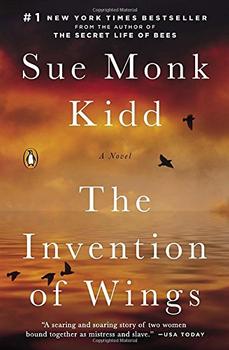Summary | Excerpt | Reading Guide | Reviews | Beyond the Book | Read-Alikes | Genres & Themes | Author Bio

This article relates to The Invention of Wings
Among the many unifying symbols in all the intertwining relationships that course through The Invention of Wings, one of the most important concerns is not another person but a quilt.
"This a story quilt," Mauma Charlotte tells her daughter Handful. "My mauma made one and her mauma before her. All my kin in Africa...kept their history on a quilt." Later, as Handful stitches the appliquéd squares together, she begins to understand just how much of her mother – her earlier life in Africa, her experiences with slavery – is in the quilt. "Mauma had sewed where she came from, who she was, what she loved, the things she suffered, and the things she'd hoped. She'd found a way to tell it."
In her book, Stitched From the Soul: Slave Quilts From the Antebellum South, folklore historian Gladys-Marie Fry notes that for enslaved women, quilting was a survival mechanism, "...a type of emotional and social release that provided...the means by which they recorded and preserved their experiences...it was their personal and communal history, recorded not on paper but on fabric." Since they were forbidden by law to learn to read and write, these story quilts became a way for slave women to validate and preserve their own experiences separate and apart from the day-to-day drudgery of involuntary servitude.
 African-American slave quilting possesses a definite yin-yang dichotomy. Many slave women were skilled in needlework and clothing construction and did much of their work on behalf of the families who owned them. In fact, the exquisitely appliquéd and stitched quilts, known as "best" quilts, still handed down in southern families were largely crafted by these women in bondage.
African-American slave quilting possesses a definite yin-yang dichotomy. Many slave women were skilled in needlework and clothing construction and did much of their work on behalf of the families who owned them. In fact, the exquisitely appliquéd and stitched quilts, known as "best" quilts, still handed down in southern families were largely crafted by these women in bondage.
For their own use, however, slave women made utility quilts out of scraps left over from clothing construction, more often from their own rough garments than the best cottons, silks and velvets belonging to the "big house." Here and there a piece of fancier material smuggled into the slave quarters, would be incorporated into what came to be known as "life" quilts. These types of folk art pieces, created communally and on their own time, became symbols of bonding and slave women could take pride in their unique creations rather than simply following the patterns they were told to fashion for their masters. As the fictional Handful observes in the novel, for each quilter, the life quilt was "the meat on her bones," and definitely a piece of each woman's individual soul.
Few of these masterpieces exist today due to natural deterioration, hard use, the vicissitudes of war and the displacement of Reconstruction. The fictional quilt in The Invention of Wings is based on two extant ones by an actual slave woman from Georgia, Harriet Powers (1837-1911). Fascinated by oral history and employing a traditional African style of appliqué, Harriet stitched local legends, Bible stories and even astronomical events such as the Leonid meteor storm of November 13, 1833.
In desperate need of money, Harriet Powers was forced to sell her "Bible" quilt (see image above). The buyer, Miss Jennie Smith of Athens, Georgia, purchased it for five dollars, and received an oral interpretation of the different squares as well. Harriet had originally asked ten but was bargained down and was only partially consoled by Miss Smith's promise to allow her to visit "the offspring of my brain," as she always referred to it. Following Jennie Smith's death, the quilt, which had not been designated in her will, made its way to the Smithsonian Institute's collections when the liquidator in charge of Smith's estate gave it to the venerable Washington, D.C.-based institution.
For information about the role of quilts in the Underground Railroad, read the 'Beyond the Book' for Song Yet Sung.
Picture of Harriett Powers's Bible quilt by Rhonda Leigh Willers of the University of Wisconsin-River Falls. Wikimedia Commons
Filed under Cultural Curiosities
![]() This "beyond the book article" relates to The Invention of Wings. It originally ran in January 2014 and has been updated for the
May 2015 paperback edition.
Go to magazine.
This "beyond the book article" relates to The Invention of Wings. It originally ran in January 2014 and has been updated for the
May 2015 paperback edition.
Go to magazine.
There is no such thing as a moral or immoral book. Books are either well written or badly written. That is all.
Click Here to find out who said this, as well as discovering other famous literary quotes!
Your guide toexceptional books
BookBrowse seeks out and recommends the best in contemporary fiction and nonfiction—books that not only engage and entertain but also deepen our understanding of ourselves and the world around us.